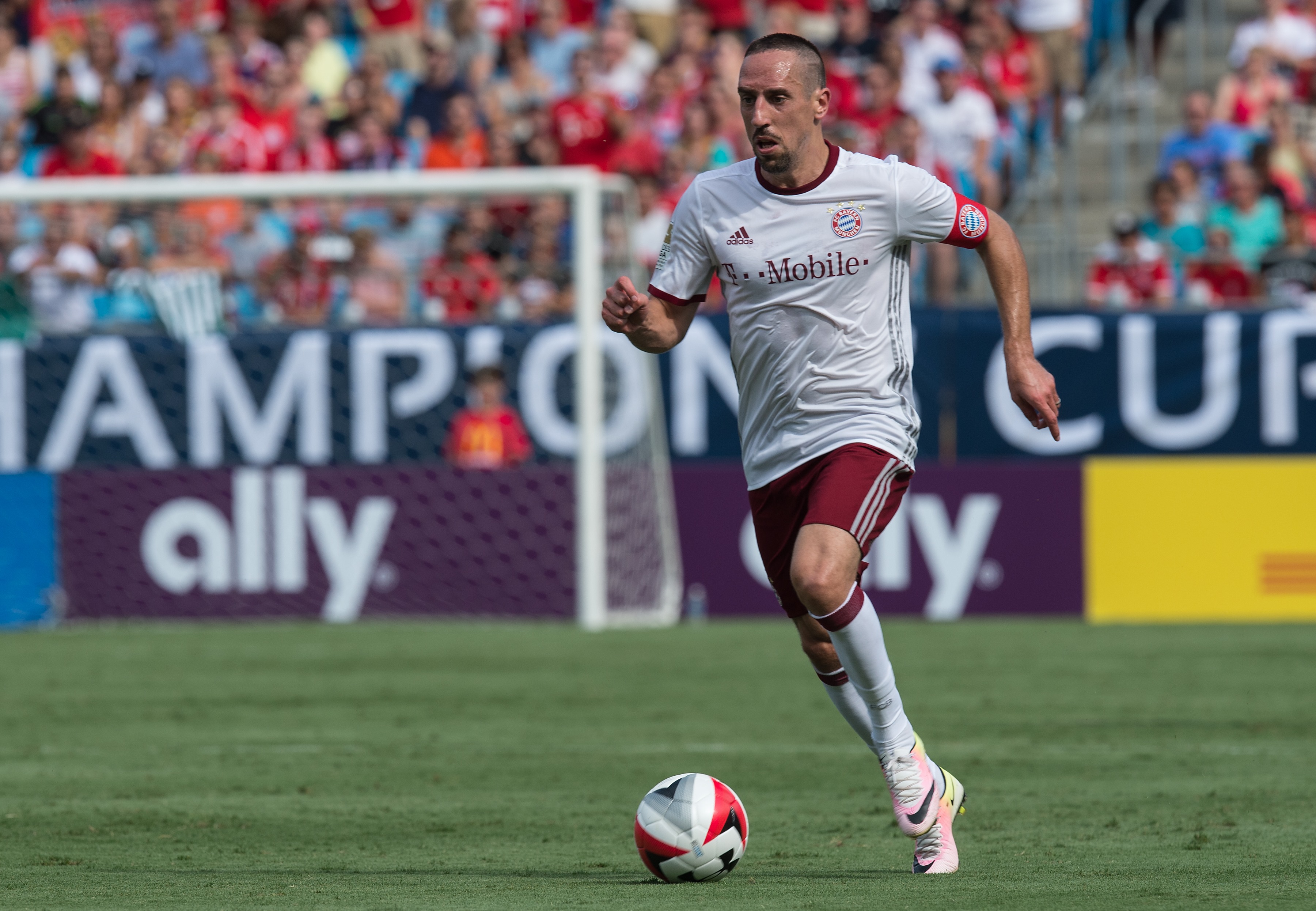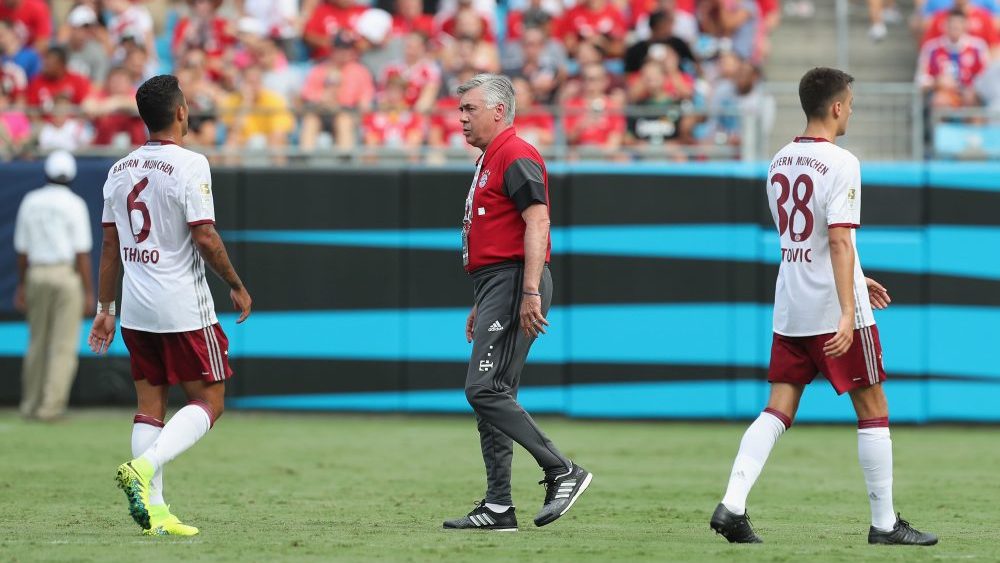Carlo Ancelotti: First conclusions
It has to be clear that the past games cannot provide all the answers to Bayern’s style of play for the upcoming season. Some players were playing in unusual positions, for example Lahm and Alaba played as half-space players in the midfield or even as wingers, while Ribery was playing as a second striker next to Julian green. Additionally the personnel in defence will most likely be completely different by the start of the season. However, it is still very interesting to observe how the current players implement Ancelotti’s tactical approaches so far.
A different kind of pressing
The first noteworthy characteristic is the way how the team is pressuring the opponent. Under Pep Guardiola all players used to try to recover the ball as fast as possible. In the past few games there was evidently less risk-taking. They are still attacking quite far up the field but way less frequently and with less intensity as well. As a result the team tries to get some rest in those phases of the game, starting to pressure the opponent only at the half way line. This is somewhat contrary to the principles of Pep Guardiola, who demanded to recover the ball as fast as possible after losing possession. The change is quite big due to the fact that circulating the ball was one of the key elements our players relied on. It requires a lot of discipline as well as compactness to control an opposing team without having the ball. The game vs. Milan showed the difficulties, which the Italians were able to exploit easily.
Regarding the future this approach in general might be quite useful for players like Coman, Costa, Ribery or Robben, who also have their strengths in speed and counter attacking football. The overall style of play was much more vertical compared to the last seasons. It was certainly dominant football although possession in general played a less important role.
Changes in the build-up play
A direct approach seems to be Carlo Ancelotti’s favourite option. The structure with only two centre backs initializing the build-up play is different to Guardiola’s idea with three players. In the past there was always a defensive midfielder dropping back between the centre-backs, supporting them. This is rarely the case anymore. In this scenario both full backs play quite offensively. It will be interesting to see how this works against stronger teams who are attacking way earlier than the last opponents. At first sight it seems to be easy to build up pressure and force our defence to play inaccurately into the last third of the pitch. Luckily the acquisition of Mats Hummels gives another option to overcome those kinds of danger with his abilities. Jerome Boateng and Mats Hummels in combination with Manuel Neuer should be able to handle most of the opposing approaches due to their precise and calm build-up play. Lately there were a few mistakes, like the one Badstuber produced against Milan and it is possible that this is Ancelotti’s biggest problem to solve over the next few weeks.
The midfield in general looks fine. There are always options available and all players are moving smoothly as well. This is certainly still the work of Pep Guardiola. Due to excellent positional play it is possible to outnumber the opponent and reach the last third of the pitch. Especially Xabi Alonso not only profits offensively (passing qualities), but also defensively (isolating wingers) by playing a bit more up front. Another novelty is that there are almost no long-passes anymore, eventhough Xabi Alonso used to work with them often in the last seasons. But maybe this element will back with the full squad on board.
Adjustments in the final third
The offence seems to struggle a bit more. This is not surprising considering the fact that players like Müller, Costa, Robben, Coman and Lewandowski are still missing. But there are some structural problems as well. The attack through the centre is barely working. The focus on attacking over the wings seems to be even heavier than before, although Ribery – the only regular winger – is playing in the centre of the pitch. He is currently present in the half-spaces as well as on the wings, in the midfield and as a supporting striker as well. This role might be the one for Thomas Müller, when he returns.
Right now the winger positions are covered by Lahm and Alaba, who will be probably drop back a line when the full squad is back in action. As a result Bernat and Rafinha are likely to deal with their role as substitutes. There are two main tasks for the winger position under Carlo Ancelotti. Firstly it is important to create space by getting into the half spaces diagonally. As a consequence both fullbacks are either able to draw away an opponent or use the given space to cross into the box. The second task is to be a playmaker. Currently there is Ribery in the centre trying to fill out that role, but Lahm and Alaba also collect a lot of touches. Their plan, to find the central players in good positions, is very often executed in a specific way: A one-two pass to create space on the wings. Going straight to the base line. Passing it back to find a player in the centre or at the back of the box.

(Photo: NICHOLAS KAMM / AFP / Getty Images)
Regarding our crosses it is quite obvious that not the initial cross, but the potential second ball in a key tactical element, which promises success. Usually there are two players in the centre trying to convert a cross while the others are covering important parts outside of the box. The target is to recover the ball as fast as possible, after or while the opponent is clearing the ball, because it is quite easy to surprise a confused defence. You may have seen this kind of tactics with Pep Guardiola as well, but especially now with many players missing it is a focused option.
As we already mentioned the centre is lacking a bit of creativity, which makes the team currently way to dependent on Ribery and Alaba, but with all the offensive players back in the next few weeks it should be possible to reduce the wing focus and create more flexibility. Sadly the past showed that without our tried and trusted wingers it was always difficult to be creative in the last third of the pitch. Even though we already have players like Thiago and Xabi Alonso who are certainly able to do so.
First conclusions
It can be said that we are experiencing a process back to normality, which should not be seen as a bad thing. The mental demand Pep Guardiola put on the players was huge. His work will stay present in the future for sure and also help Ancelotti as well. The Italian tries to create pressure more carefully and relies on compactness without the ball. On the other side, when in possession he likes to play straight-forward and is not afraid to take risks. At the moment accuracy as well as balance is missing, but there are a few weeks left for our new coach to fix the current problems in preseason.









